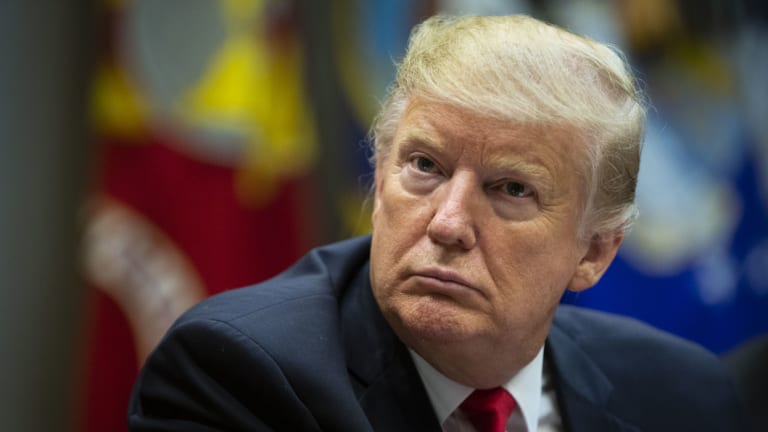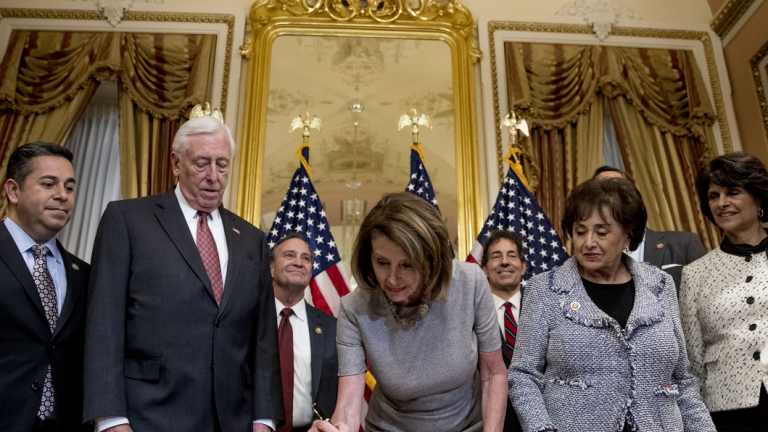Just what does Trump mean by a ‘wall’, anyway?

Several news sources used the accurate but uncharitable term "cave" to describe US President Donald Trump's capitulation on Friday to the Democrats' position on the wall and the US government shutdown.
US President Donald Trump on Friday.Credit:Bloomberg
It was a clear victory for the Democrats, but House Speaker Nancy Pelosi and Senate minority leader Chuck Schumer were prudently restrained in their celebration.
The victory is only a three-week reprieve and there's no reason to believe Trump has learnt this episode's most important lesson: a government shutdown is a terrible way to implement policy.
In three weeks, the government could be shut down again or, as he threatens, Trump could declare a national emergency.
More than a modest victory lap by Democrats would be counterproductive to the essential goal: finding a solution that will keep the government open after Febuary 15.
Where to start? Maybe with a set of questions, all of which have an answer.
For example, just how long would Trump's wall be? When "Build the Wall" became a red-meat mantra at Trump rallies, it's clear that many of his supporters envisioned a seamless concrete barricade stretching more than 3000 kilometres from the Gulf of Mexico to the Pacific.
Trump encouraged this perception by describing the wall as big and beautiful and, at times, as tall as 20 metres. But I've been unable to find any place where Trump himself said the wall needs to be 3000 kilometres long.
In fact, as early as 2015, Trump was conceding that 1500 kilometres of wall would be sufficient. At present around 1000 kilometres of the border has some sort of barrier. The 500-kilometre gap doesn't seem – and we are dealing with perception here – nearly as large as the imaginary gap between "no wall" and "all wall", two positions hardly anyone actually embraces.
The figures above are somewhat misleading. According to a 2017 Government Accountability Office report, the border has only 570 kilometres of pedestrian barriers; much of the rest are low-lying vehicle obstructions not designed to deter illegal foot traffic.
Further, in many places the pedestrian barriers don't represent much of an obstacle to a determined crosser.
In short, there may be places along the border where Democrats – who have already accepted the need for some pedestrian barriers – might agree that additional barriers could be useful or that existing barriers could be improved.
House Speaker Nancy Pelosi signs a deal to reopen the government.Credit:AP
Other questions could provide more clarity. What's the comparative cost of a concrete wall versus a steel wall? Which is more durable? Does steel have higher maintenance costs than concrete?
What sort of infrastructure – roads, lighting and so on – is required? What provisions can be made to prevent tunnelling? Where are the places that a physical barrier would be most effective? What's the useful life expectancy of a wall?
And, most important, how much will Trump's wall actually cost? The $US5.7 billion ($8 billion) that he demanded has always been a slippery figure, and lately he's described it as a down-payment for a wall whose total cost depends on the answers to the questions above.
Those questions do have answers, and in a well-run administration they would have been answered long before the original proposal was made.
The situation on the southern border is not a crisis. Real security involves better technology, more border patrol agents, more efficient immigration courts and, probably, physical barriers.
Better yet, Americans could ask themselves if they've done enough to help their neighbours to the south improve the conditions that drive people north.
In the meantime, the nation's legislative branch has less than three weeks to manage a crisis that has been generated by the executive branch.
This means managing an erratic, temperamental President who is only just learning the complexities of negotiating in a democracy where power is shared.
Asking the administration to provide specific details about Trump's "wall" will help focus the negotiations and may enable Democrats and reasonable Republicans to give the President enough to placate his fragile ego.
Trump is going to assert that he "won" no matter how things turn out, which is fine as long as Congress can manage to do the right thing.
Tribune
Source: Read Full Article

